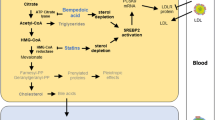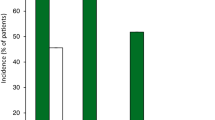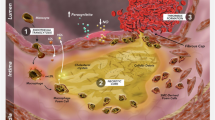Abstract
Atherosclerosis (AS) is a chronic inflammatory arterial disease, in which abnormal lipid metabolism and foam cell formation play key roles. Histamine is a vital biogenic amine catalyzed by histidine decarboxylase (HDC) from L-histidine. Histamine H1 receptor (H1R) antagonist is a commonly encountered anti-allergic agent in the clinic. However, the role and mechanism of H1R in atherosclerosis have not been fully elucidated. Here, we explored the effect of H1R on atherosclerosis using Apolipoprotein E-knockout (ApoE−/−) mice with astemizole (AST, a long-acting H1R antagonist) treatment. The results showed that AST increased atherosclerotic plaque area and hepatic lipid accumulation in mice. The result of microarray study identified a significant change of endothelial lipase (LIPG) in CD11b+ myeloid cells derived from HDC-knockout (HDC−/−) mice compared to WT mice. Blocking H1R promoted the formation of foam cells from bone marrow-derived macrophages (BMDMs) of mice by up-regulating p38 mitogen-activated protein kinase (p38 MAPK) and LIPG signaling pathway. Taken together, these findings demonstrate that blocking H1R signal aggravates atherosclerosis by promoting abnormal lipid metabolism and macrophage-derived foam cell formation via p38 MAPK-LIPG signaling pathway.
Key messages
-
Blocking H1R signal with AST aggravated atherosclerosis and increased hepatic lipid accumulation in high-fat diet (HFD)-fed ApoE−/− mice.
-
Blocking H1R signal promoted macrophage-derived foam cell formation via p38 MAPK-LIPG signaling pathway.







Similar content being viewed by others
Availability of data and materials
The datasets used and/or analyzed during the current study are available from the corresponding author on reasonable request.
References
Liu YX, Yuan PZ, Wu JH, Hu B (2021) Lipid accumulation and novel insight into vascular smooth muscle cells in atherosclerosis. J Mol Med (Berl) 99:1511–1526
Silvis MJM et al (2021) Immunomodulation of the NLRP3 Inflammasome in Atherosclerosis, Coronary Artery Disease, and Acute Myocardial Infarction. J Cardiovasc Transl Res 14:23–34
Han Y, Peng L, Wang T (2022) Tadr is an axonal histidine transporter required for visual neurotransmission in Drosophila. Elife 11:e75821
Sudarikova AV, Fomin MV, Yankelevich IA, Ilatovskaya DV (2021) The implications of histamine metabolism and signaling in renal function. Physiol Rep 9:e14845
Kimura S et al (2018) Relationship between CCL22 expression by vascular smooth muscle cells and macrophage histamine receptors in atherosclerosis. J Atheroscler Thromb 25:1240–1254
Jang J et al (2022) Anti-inflammatory activities of an anti-histamine drug, loratadine, by suppressing TAK1 in AP-1 pathway. Int J Mol Sci 23(7):3986
Wang KY et al (2011) Histamine deficiency decreases atherosclerosis and inflammatory response in apolipoprotein E knockout mice independently of serum cholesterol level. Arterioscler Thromb Vasc Biol 31:800–807
Yamada S, Wang KY, Tanimoto A, Sasaguri Y (2015) Novel function of histamine signaling in hyperlipidemia-induced atherosclerosis: Histamine H1 receptors protect and H2 receptors accelerate atherosclerosis. Pathol Int 65:67–80
Raveendran VV et al (2014) Chronic ingestion of H1-antihistamines increase progression of atherosclerosis in apolipoprotein E-/- mice. PLoS ONE 9:e102165
Yang XD et al (2011) Histamine deficiency promotes inflammation-associated carcinogenesis through reduced myeloid maturation and accumulation of CD11b+Ly6G+ immature myeloid cells. Nat Med 17:87–95
Zhu B et al (2022) Abnormal histidine metabolism promotes macrophage lipid accumulation under Ox-LDL condition. Biochem Biophys Res Commun 588:161–167
Guo H et al (2022) A novel therapeutic strategy for atherosclerosis: autophagy-dependent cholesterol efflux. J Physiol Biochem 78:557–572
Sylvers-Davie KL, Segura-Roman A, Salvi AM, Schache KJ, Davies BSJ (2021) Angiopoietin-like 3 inhibition of endothelial lipase is not modulated by angiopoietin-like 8. J Lipid Res 62:100112
Wang C et al (2019) Sex hormones affect endothelial lipase-mediated lipid metabolism and atherosclerosis. Lipids Health Dis 18:226
Chen T et al (2015) Highly selective “Off-On” fluorescent probe for histidine and its imaging in living cells. Biosens Bioelectron 66:259–265
Droin C et al (2021) Space-time logic of liver gene expression at sub-lobular scale. Nat Metab 3:43–58
Ma C et al (2020) Formononetin attenuates atherosclerosis via regulating interaction between KLF4 and SRA in apoE(-/-) mice. Theranostics 10:1090–1106
Kumar S et al (2021) Vitamin D3-VDR-PTPN6 axis mediated autophagy contributes to the inhibition of macrophage foam cell formation. Autophagy 17:2273–2289
Zhang X et al (2014) Angiotensin II upregulates endothelial lipase expression via the NF-kappa B and MAPK signaling pathways. PLoS ONE 9:e107634
Yue X et al (2016) Endothelial lipase is upregulated by interleukin-6 partly via the p38 MAPK and p65 NF-kappaB signaling pathways. Mol Med Rep 14:1979–1985
Aimo A et al (2018) The IL-33/ST2 pathway, inflammation and atherosclerosis: Trigger and target? Int J Cardiol 267:188–192
Chan YH, Ramji DP (2022) Probing Inflammasome Activation in Atherosclerosis. Methods Mol Biol 2419:313–331
González L, Rivera K, Andia ME, Martinez Rodriguez G (2022) The IL-1 Family and its role in atherosclerosis. Int J Mol Sci 24(1):17
Munjal A, Khandia R (2020) Atherosclerosis: orchestrating cells and biomolecules involved in its activation and inhibition. Adv Protein Chem Struct Biol 120:85–122
Kim CW, Oh ET, Park HJ (2021) A strategy to prevent atherosclerosis via TNF receptor regulation. FASEB J 35:e21391
Cheon SY, Cho K (2021) Lipid metabolism, inflammation, and foam cell formation in health and metabolic disorders: targeting mTORC1. J Mol Med (Berl) 99:1497–1509
Cadenas C et al (2019) LIPG-promoted lipid storage mediates adaptation to oxidative stress in breast cancer. Int J Cancer 145:901–915
Qiu G, Ho AC, Yu W, Hill JS (2007) Suppression of endothelial or lipoprotein lipase in THP-1 macrophages attenuates proinflammatory cytokine secretion. J Lipid Res 48:385–394
Jaye M et al (1999) A novel endothelial-derived lipase that modulates HDL metabolism. Nat Genet 21:424–428
Han H et al (2019) Impact of serum levels of lipoprotein lipase, hepatic lipase, and endothelial lipase on the progression of coronary artery disease. J Interv Med 2:16–20
Ma K et al (2003) Endothelial lipase is a major genetic determinant for high-density lipoprotein concentration, structure, and metabolism. Proc Natl Acad Sci USA 100:2748–2753
Ishida T et al (2004) Endothelial lipase modulates susceptibility to atherosclerosis in apolipoprotein-E-deficient mice. J Biol Chem 279:45085–45092
Reustle A, Torzewski M (2018) Role of p38 MAPK in atherosclerosis and aortic valve sclerosis. Int J Mol Sci 19(12):3761
Zhao M et al (2002) Activation of the p38 MAP kinase pathway is required for foam cell formation from macrophages exposed to oxidized LDL. APMIS 110:458–468
Acknowledgements
We would like to thank Weiwei Zhang, Jianguo Jia, Bingyu Li, and Sanli Qian for their contributions and technical support to this work.
Funding
The authors gratefully acknowledge the grants from the National Natural Science Foundation of China (82170258), the Science Foundation of Shanghai Committee of Science and Technology (22ZR1446700), Shanghai Sailing Program (23YF1431600), the Key Project of the Science and Technology Committee of Baoshan district of Shanghai (21-E-42), and Guangdong Basic and Applied Basic Research Foundation (2022A1515140176).
Author information
Authors and Affiliations
Contributions
Xiangdong Yang, Chun Xiao and Yunzeng Zou designed the study and organized the manuscript. Baoling Zhu, Yi Yang, Xiangfei Wang and Dili Sun performed the experiments and wrote the manuscript. Xiyang Yang and Dili Sun analyzed the data and revised the manuscript. Xiaowei Zhu and Suling Ding contributed to the design of the study and the revision of the manuscript. All authors reviewed and approved the final manuscript.
Corresponding authors
Ethics declarations
Ethics approval
All animal-related experiments in this study were carried out according to the Guide for the Care and Use of Laboratory Animals published by the US National Institutes of Health (NIH Publication, 8th Edition, 2011). All of experimental protocols were approved by the Committee on the Ethics of Animal Experiments of Fudan University.
Consent for publication
Not applicable.
Conflicts of interest
The authors declare that there are no conflicts of interest to disclose.
Additional information
Publisher's Note
Springer Nature remains neutral with regard to jurisdictional claims in published maps and institutional affiliations.
Rights and permissions
Springer Nature or its licensor (e.g. a society or other partner) holds exclusive rights to this article under a publishing agreement with the author(s) or other rightsholder(s); author self-archiving of the accepted manuscript version of this article is solely governed by the terms of such publishing agreement and applicable law.
About this article
Cite this article
Zhu, B., Yang, Y., Wang, X. et al. Blocking H1R signal aggravates atherosclerosis by promoting inflammation and foam cell formation. J Mol Med (2024). https://doi.org/10.1007/s00109-024-02453-5
Received:
Revised:
Accepted:
Published:
DOI: https://doi.org/10.1007/s00109-024-02453-5




